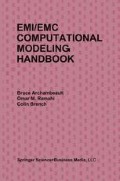Abstract
It is well established that electromagnetic theory forms the backbone of electromagnetic interference and compatibility work. A good understanding of electromagnetic theory is highly desirable; however, it does not by itself lead to an understanding of the complexities of the electromagnetic interference phenomenon. This is because the interactions of electromagnetic fields with complex objects, as would be the case in real applications, cannot simply be predicted without abstraction of reality or, in other words, without creating a model of the physical system being analyzed. Creating an electromagnetic model that faithfully resembles the electromagnetic field behavior in the physical world is a challenging exercise that requires basic understanding of electromagnetic theory but would also require a good understanding of circuit theory, and of course, a sense of which physical factors are relevant to the model.
Access this chapter
Tax calculation will be finalised at checkout
Purchases are for personal use only
Preview
Unable to display preview. Download preview PDF.
References
J.D. Jackson, Classical Electrodynamics, John Wiley & Sons, New York, 1962.
E.C. Jordan and K.G. Balmain, Electromagnetic Waves and Radiating Systems, Prentice-Hall, Englewood Cliffs, N.J., 1968.
W.L. Stutzman and G.A. Thiele, Antenna Theory and Design, John Wiley & Sons, New York, 1981.
S. Ramo and J.R. Whinnery, Fields and Waves in Modern Radio, John Wiley & Sons, New York, 1944.
W.H. Hayt, Jr., Engineering Electromagnetic, McGraw-Hill, New York, 1981.
R.F. Harrington, Time-Harmonic Electromagnetic Fields, McGraw-Hill, New York, 1961.
C.A. Balanis, Advanced Engineering Electromagnetics, John Wiley & Sons, New York, 1989.
L.C. Shen and J.A. Kong, Applied Electromagnetics, PWS Engineering, Boston, 1987.
R.E. Collin, Field Theory of Guided Waves, McGraw-Hill, New York, 1960.
R.C. Booton, Jr., Computational Method for Electromagnetics and Microwaves, John Wiley & Sons, New York, 1992.
Author information
Authors and Affiliations
Rights and permissions
Copyright information
© 1998 Springer Science+Business Media New York
About this chapter
Cite this chapter
Archambeault, B., Ramahi, O.M., Brench, C. (1998). Electromagnetic Theory and Modeling. In: EMI/EMC Computational Modeling Handbook. Springer, Boston, MA. https://doi.org/10.1007/978-1-4757-5124-6_2
Download citation
DOI: https://doi.org/10.1007/978-1-4757-5124-6_2
Publisher Name: Springer, Boston, MA
Print ISBN: 978-1-4757-5126-0
Online ISBN: 978-1-4757-5124-6
eBook Packages: Springer Book Archive

